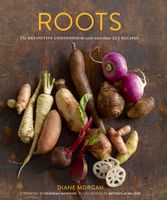Prue Leith's latest book is now on ckbk. Get 25% off ckbk Membership
History and Lore
By Diane Morgan
Published 2012
Parsnips, which grow wild in temperate Europe and western Asia, have been cultivated since Roman times. In the first century A.D., Pliny the Elder used the Latin word pastinaca for both carrots and parsnips. During the Middle Ages, before the introduction of the potato and when sugar and honey were scarce and expensive, this sweet, starchy member of the family Apiaceae did double duty in Europe: it was a staple vegetable and a sweetener, the latter made by evaporating its juices and using the brown residue that remained like honey. Parsnips were regular fare for the lower classes of central and northern Europe, especially for observant Catholics on fasting days. In the nineteenth century, both the English and the Irish made parsnip wine, which some consumers considered reminiscent of a sweet Madeira, and parsnip beer was popular in the northern part of Ireland. Today, Italian farmers who breed pigs for the manufacturers of Parma prosciutto often include parsnips in the pigs’ diet.
Become a Premium Member to access this page
Unlimited, ad-free access to hundreds of the world’s best cookbooks
Over 150,000 recipes with thousands more added every month
Recommended by leading chefs and food writers
Powerful search filters to match your tastes
Create collections and add reviews or private notes to any recipe
Swipe to browse each cookbook from cover-to-cover
Manage your subscription via the My Membership page
Part of
Advertisement
Advertisement


